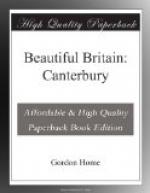[Illustration: Canterbury cathedral from the north west. The state central or “Bell Harry” Tower is one of the most beautiful works of the Perpendicular period in existence.]
As the first church mentioned in history associated with Christian worship St. Martin’s occupies a unique position, and yet the fabric of the little building does not conclusively prove that it is even in part the actual church of this fascinating period. Cautious archaeologists, represented by Mr. J. T. Micklethwaite, regard the earliest work in St. Martin’s as belonging to the Saxon period, Roman materials having merely been worked up by the later builders. On the other hand, there are various careful antiquaries who are willing to accept the oldest parts of the church as Roman, and claim that St. Martin’s is a Christian church put up during the Roman occupation. Perhaps the problem will be solved by further discoveries, but until then it seems wiser to regard St. Martin’s as being in part a very early Saxon building, very probably standing on the site of the restored Roman church in which Queen Bertha worshipped before Augustine’s arrival. Even if it were possible to state that parts of the walls were Roman, it would not be an easy matter to say whether the building were older than the two early Christian churches of North Cornwall, preserved through the ages by the drifting sand of that exposed coastline; therefore, to write, as so many have done, that St. Martin’s is the oldest Christian church in England, is not justified by the facts. Besides St. Martin’s, William Thorne, a fourteenth century chronicler, makes mention of “a temple or idol-place where Ethelbert had been wont to pray and to sacrifice to demons,” and this building, instead of being destroyed, was purged from its defilements and idols and hallowed by Augustine when he dedicated it to St. Pancras the Roman boy-martyr. When the site, about halfway between St. Martin’s and St. Augustine’s, was excavated in 1901, it was found to possess a nave about 47 feet long by 26 feet wide, with an apsidal chancel nearly the same width and depth separated from the nave by four Roman columns, and Mr. W.H. St. John Hope, of the Society of Antiquaries, who carried out the operations with Canon Routledge, has suggested that this may be the first church built by Augustine out of Roman materials ready to hand, while the larger one, dedicated to Saints Peter and Paul, a little to the west, was slowly being constructed. It was not finished when, in 605, Augustine died, and eventually the dedication included the canonized first archbishop of the English Church, who was buried in the building when it was finished. The other great figures of the period—Ethelbert and his Queen, and her chaplain—were also laid to rest in the church. A few years ago it was only possible to form an idea of this large structure from the Norman north wall of the nave and part of the north-west tower, but now that nearly the whole




